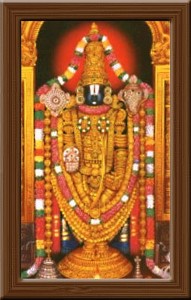|
| |
Thirupathi-Thirumala

The ancient and
sacred temple of Sri Venkateswara is located on the seventh peak, Venkatachala (Venkata
Hill) of the Tirupati Hill, and lies on the southern banks of Sri Swami
Pushkarini. It is in Andhra Pradesh. India
The
temple of Sri Venkateswara has acquired unique sanctity in Indian religious
lore. The Sastras, Puranas, Sthala Mahatyams and Alwar hymns unequivocally
declare that, in the Kali Yuga, one can attain mukti, only by worshipping
Venkata Nayaka or Sri Venkateswara.
The
benefits acquired by a piligrimage to Venkatachala are mentioned in the Rig
Veda and Asthadasa Puranas. In these epics, Sri Venkateswara is described as
the great bestower of boons. There are several legends
associated with the manifestation of the Lord at Tirumala
Sri Venkatachala Mahatmya
is referred to in several Puranas, of which the most important are the Varaha
Purana and the Bhavishyottara Purana.
The printed work contains
extracts from the Varaha Purana, Padma Purana, Garuda Purana, Brahmanda Purana,
Markandeya Purana, Harivamsa, Vamana Purana, Brahma Purana, Brahmottara Purana,
Aditya Purana, Skanda Purana and Bhavishyottara Purana. Most of these extracts
describe the sanctity and antiquity of the hills around Tirumala and the
numerous teerthams situated on them.
The legends taken from the
Venkatachala Mahatmya and the Varaha Purana, pertaining to the manifestation of
the Lord at Tirumala, are of particular interest.
According to the Varaha
Purana, Adi Varaha manifested Himself on the western bank of the Swami
Pushkarini, while Vishnu in the form of Venkateswara came to reside on the
southern bank of the Swami Pushkarini.
One day, Rangadasa, a
staunch devotee of Vishnu, in the course of his pilgrimage, joined Vaikhanasa
Gopinatha, who was going up the Tirumala Hill for the daily worship of Lord
Venkateswara. After bathing in the Swami Pushkarini, he beheld the lotus-eyed
and blue-bodied Vishnu beneath a tamarind tree. Vishnu was exposed to the sun,
wind and rain and was only protected by the extended wings of Garuda.
Rangadasa was astounded by
the wonderful sight. He raised a rough wall of stones around the deity, and
started supplying flowers faithfully to Gopinatha everyday for Vishnu's worship.
One day, Rangadasa was
distracted by a Gandharva king and his ladies. Consequently, he forgot to supply
flowers to Gopinatha for Vishnu's worship. The Lord then revealed Himself and
told Rangadasa that He had been testing the latter's continence, but Rangadasa
had not been steadfast and had succumbed to temptation.
However, the Lord accepted
and appreciated Rangadasa's devoted service to Him till then, and blessed
Rangadasa that he would be reborn as an affluent ruler of a province and would
enjoy the earthly pleasures. He would continue to serve the Lord, construct a
beautiful temple with a vimana and high surrounding walls, and thereby
earn eternal glory.
Rangadasa was reborn as
Tondaman, the son of the royal couple, Suvira and Nandini. Tondaman enjoyed a
pleasurable life as a young man. One day, he set out on a hunting expedition on
the Tirumala Hill, and with the help of a forester, saw Vishnu under the
tamarind tree. Tondaman returned home, deeply affected by the vision of Vishnu.
Tondaman later inherited his
father's kingdom, Tondamandalam. In accordance with the directions given by Adi
Varaha to a forester, Tondaman constructed a prakaram and dvara gopura,
and arranged for regular worship of the Lord (according to Vaikhanasa Agama).
In the Kali Yuga, Akasaraja
came to rule over Tondamandalam. His daughter Padmavathi was married to
Venkateswara. The marriage, officiated by Brahma, was celebrated with great pomp
and splendour.
More....
| |
|



